In the two of these three articles about telling stories in paintings using the multiplex technique (or ‘continuous narrative’), I have shown examples stretching from classical Rome to the Renaissance, the period over which it is claimed to have been used. Far from it falling into disuse during the sixteenth century, the last article showed it alive and well right up to its end. This article shows what has happened since, and ends by looking briefly at its appearance in paintings in Asian art.
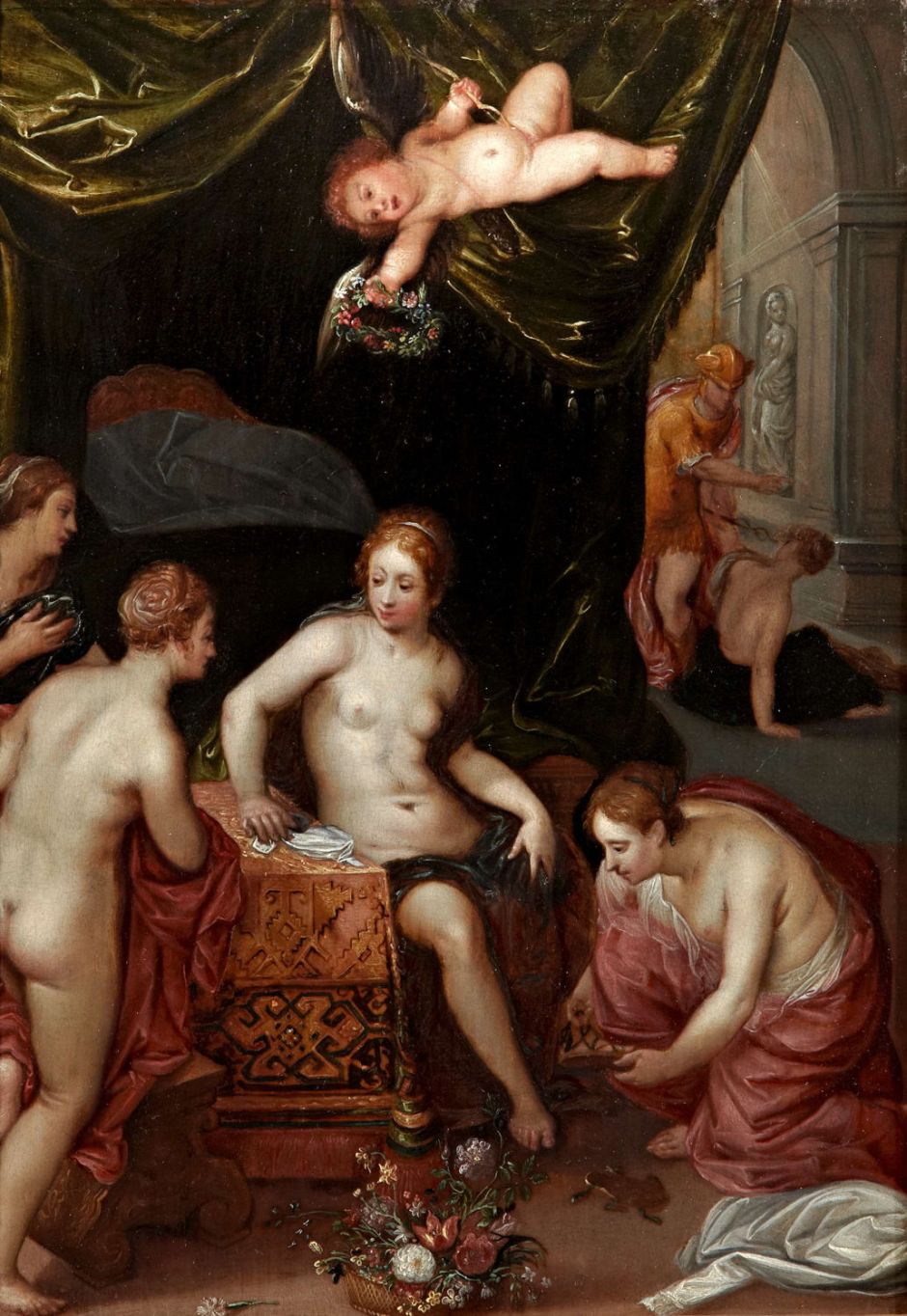
Hendrick van Balen the Elder’s Herse and her Sisters with Mercury (c 1600-32) tackles one of the lesser-known myths in Ovid’s Metamorphoses with a composite of two scenes on a single panel. At the right, Mercury is seen negotiating his way past Aglauros, Herse’s guardian. The majority of the painting shows the sisters preparing Herse to welcome Mercury in her best sandals and finest clothes, which is clearly an earlier moment in time.
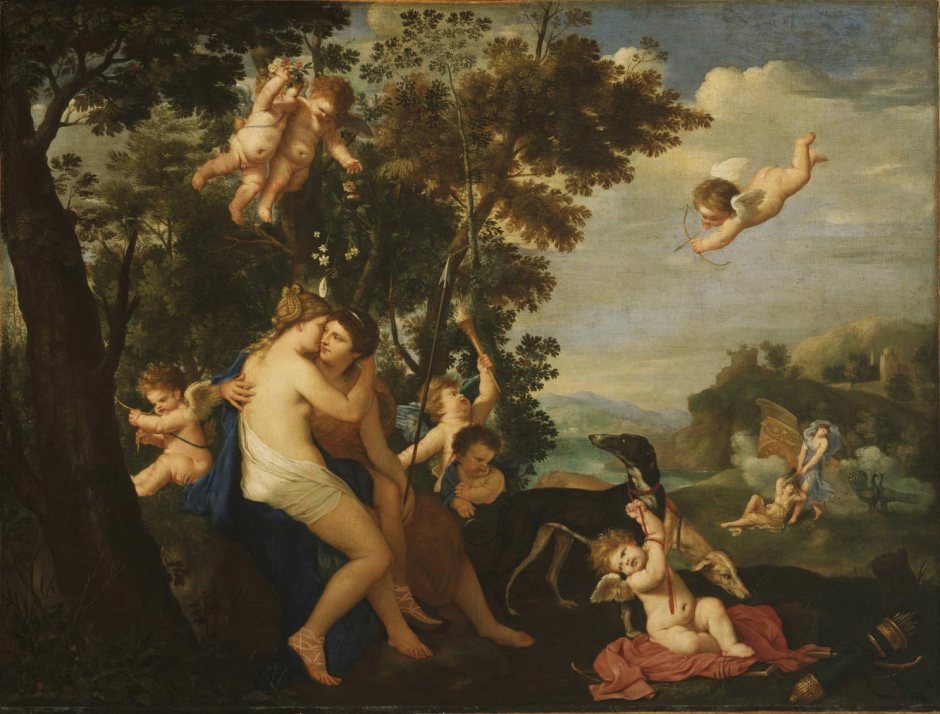
Attributed to Karel Philips Spierincks in about 1630, this painting of Jupiter and Callisto follows a similar model. In the foreground, Jupiter, disguised as the goddess Diana, embraces Callisto during her seduction. In the distance, we see the jealous Juno (accompanied by her distinctive peacocks) later dragging Callisto along by her hair before the goddess transforms her into a bear.
The early seventeenth century was the time during which many great post-Renaissance narrative painters – Rubens, the Brueghels, and Poussin, for example – were active. Although not known for their use of multiplex narrative, even they succumbed to using it at times.
We have considerable insight into Nicolas Poussin’s painting of The Israelites Gathering the Manna in the Desert from 1637-39, thanks to the artist’s letter of about 1637 (repeated in a 1639 letter to Chantelou, who commissioned the painting). In that he revealed that he was showing three separate phases which the Israelites went through: the starved state to which the Israelites were reduced before the provision of manna, the joy they experienced when the manna was provided, and its effect in improving their respect for the leaders.

Poussin uses colour and light, together with signs in body language, to guide our gaze through the complexity of his painting. The details below show each of the scenes which it incorporates.
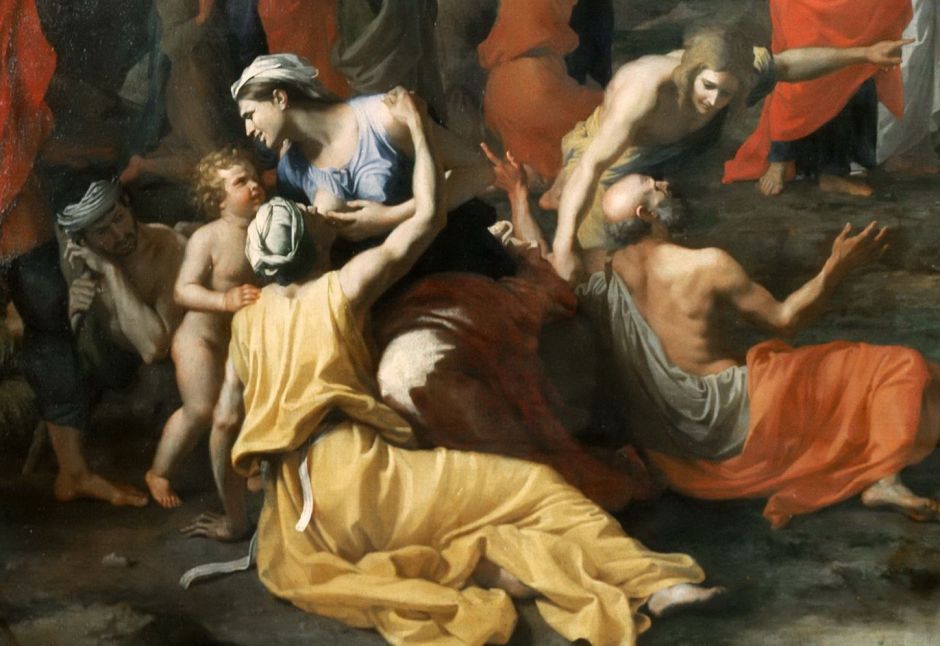
Closest to us, at the left, is a group of five figures who are still battling with starvation. Among these are a woman with a toddler, who is suckling not that infant, but her aged mother, wearing the yellow robes. To the left of the child is a man who might have come from Géricault’s Raft of the Medusa, propping his head against a stick. To the right is an elderly man, being helped up by a woman who is pointing to the right of the painting, although he is pointing back (towards Moses and Aaron), still asking what their leaders had done to address their predicament. This scene shows the earliest moment in time.
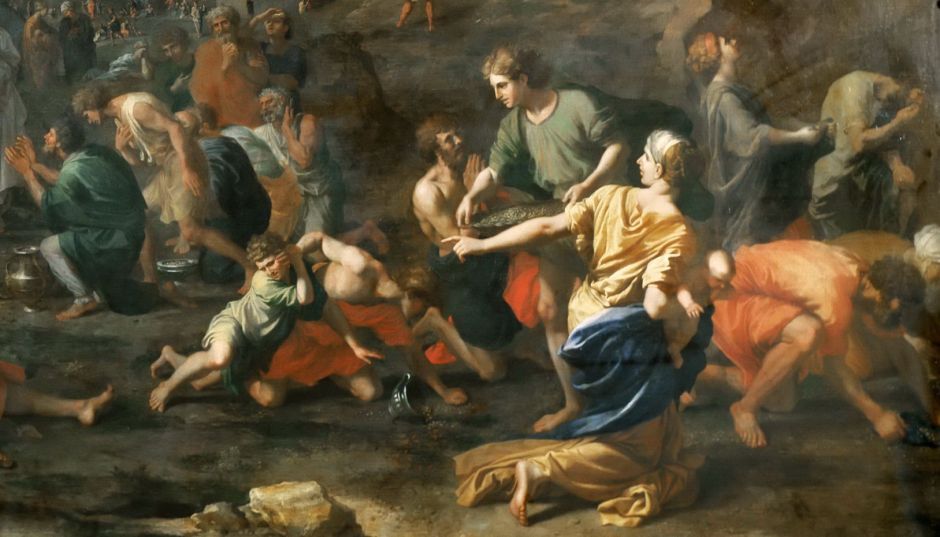
Follow the woman’s pointing arm across to the right of the painting, and there is a larger group who are brightly lit and brilliantly coloured. The foreground contains nine figures who are busy gathering the manna in the way prescribed by God. Two of them look up to heaven and express their gratitude, but two younger men (or older boys) are fighting to collect their day’s ration, and others seem to be reminding them of the rules. The woman in yellow is here pointing back at the first group to complete the link between them. This is the second moment in time.
Behind and to the left, a cluster of about eight men seem to be expressing their gratitude in deliverance, and some look left and up towards the figures of Moses and Aaron.
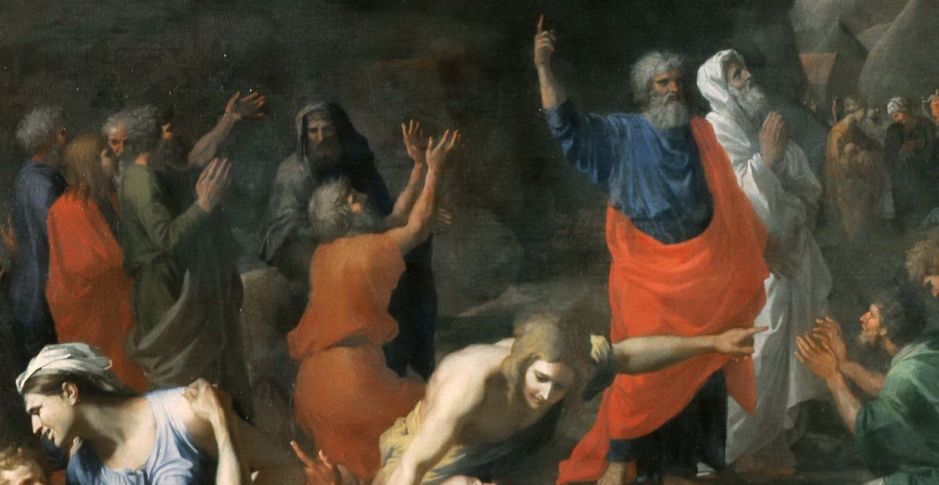
The two leaders, brightly lit and coloured, stand slightly further back. Behind them, to the left in the painting, are some fans, their hands raised to heaven, applauding Moses and Aaron.
For once, at least, Poussin abandoned temporal unity – this painting does not depict a single moment in time – in order to tell the complete story using multiplex narrative.
This remained controversial even after the artist’s death. The French Académie Royale de Peinture et de Sculpture organised a series of lectures and debates on his paintings in 1667, and devoted one complete session, led by Charles le Brun, to consider this painting. Le Brun’s lecture was recorded by André Félibien, published in a book of the lectures and in Félibien’s biography of Poussin, and has been the basis for research, comment, and debate ever since.
We also have evidence that multiplex narrative was still acceptable in book illustrations towards the middle of the seventeenth century.
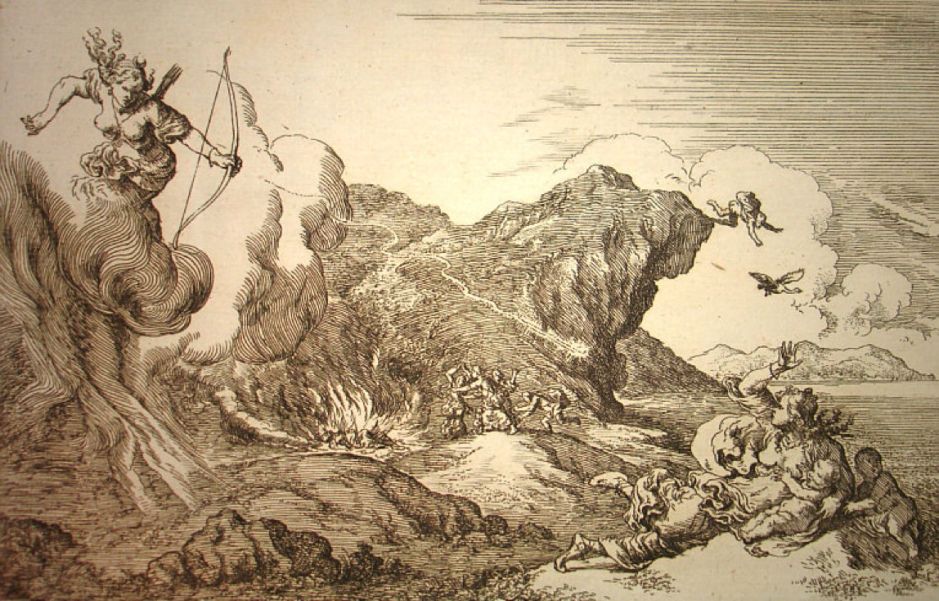
Johann Wilhelm Baur’s set of engravings to illustrate Ovid’s Metamorphoses include a particularly fine account of Chione (c 1639) which has three separate scenes. At the left, in the foreground, the vengeful Diana has just loosed an arrow, which is still in flight, at Chione, on the right. The arrow impales Chione’s tongue, as revenge for her boastfulness, and kills her.
Behind them, in the centre, Chione’s father Daedalion tries to throw himself on his daughter’s funeral pyre, following which he hurls himself from a sea cliff, and is transformed into a somewhat ungainly hawk.
Surviving examples of multiplex narrative become very sparse between 1650 and 1800, a period in which narrative painting became somewhat formulaic and lacking in innovation.
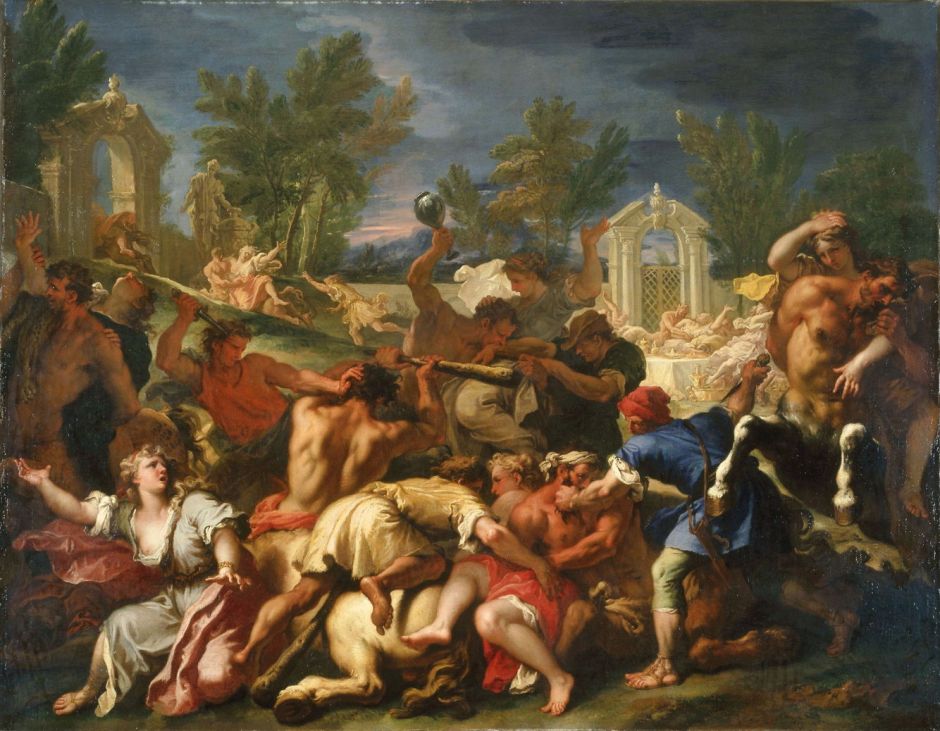
This didn’t stop Sebastiano Ricci from using it in The Battle of the Lapiths and Centaurs in about 1705, though. In the left background, he shows the event which sparked the battle off, with Hippodame being carried away by the centaur Eurytus. In the right middle distance is a later scene of centaurs raping other Lapith women at the wedding feast, and the foreground is filled with even later scenes of murderous fighting.
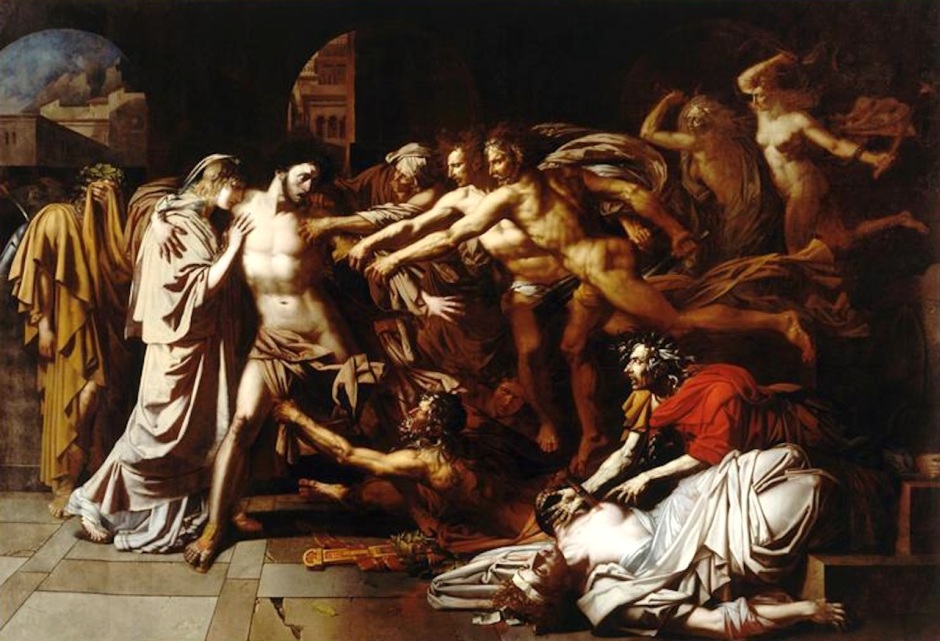
Philippe-Auguste Hennequin’s complex painting of The Remorse of Orestes from 1800 uses the Furies as a tool for showing multiplex narrative. Orestes is at the left, the centre of attention, and his right arm is holding his sister Electra. He is under attack by a small army of Furies and spirits, including the murdered body of Clytemnestra, on the floor, and Agamemnon.
Hennequin doesn’t use spatial separation of these scenes, but demarcates them with light. This encourages the viewer to see them as the more modern narrative device of flashback.
In 1836, as if to celebrate the two-hundredth anniversary of Poussin’s The Israelites Gathering the Manna in the Desert, the Father of Impressionism Camille Corot used blatant traditional multiplex narrative, in his Diana and Actaeon.
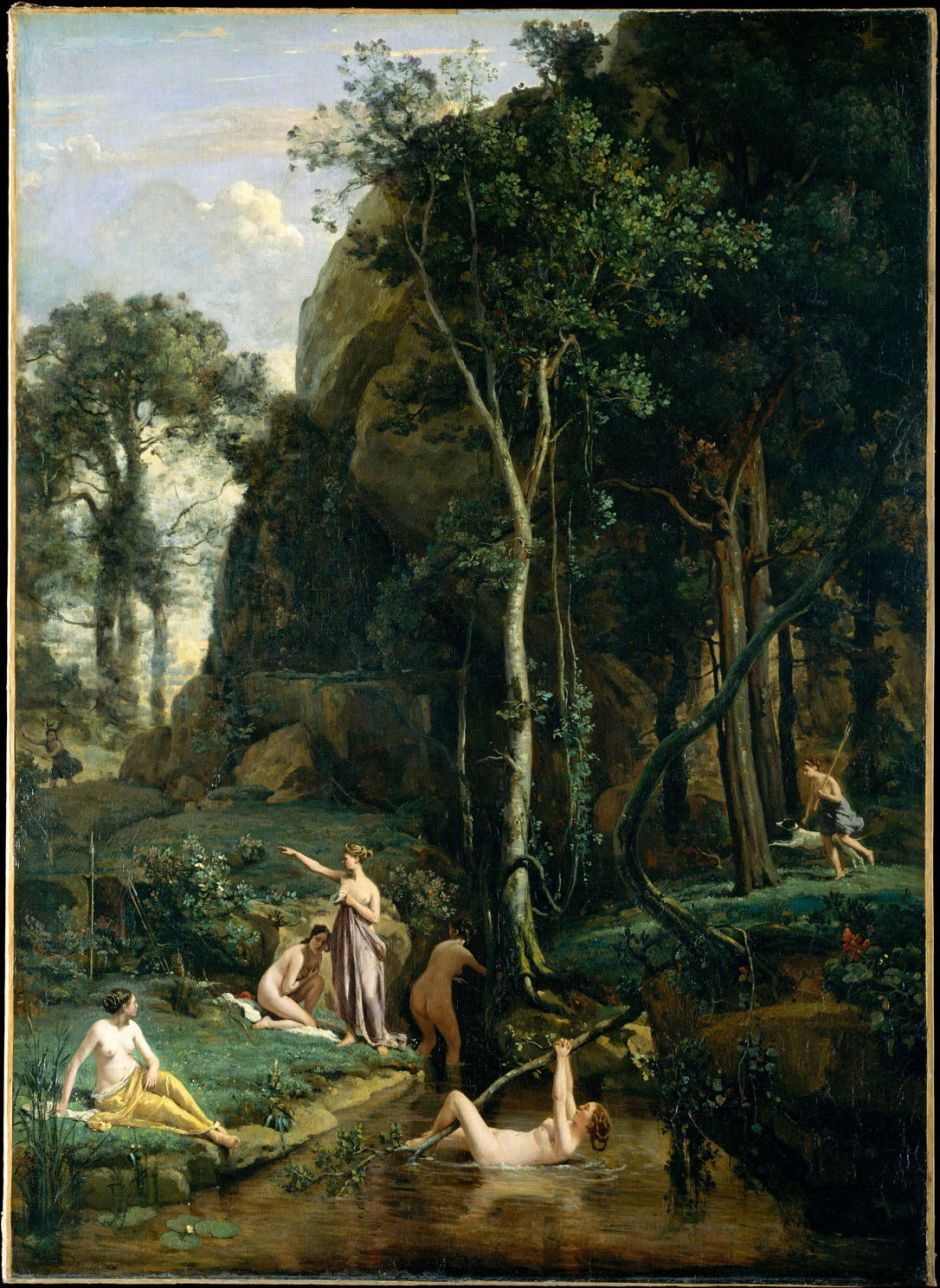
At the centre of Corot’s painting, Diana and her attendant nymphs are bathing in a stream, and soaking up the sunshine. At the right, Actaeon with one of his hunting dogs is just about to run straight into them. Diana, appropriately crowned, stands pointing to the distant figure at the left – which is again Actaeon, antlers growing from his head as she transforms him into a stag.
Actaeon appears twice in spatially separate scenes, with Diana and her group being part of both. In the first, they are simply bathing and larking about, but in the second Diana stands, points, and transforms Actaeon. This may be an archaic mode of narrative, but Corot has been innovative in its implementation.
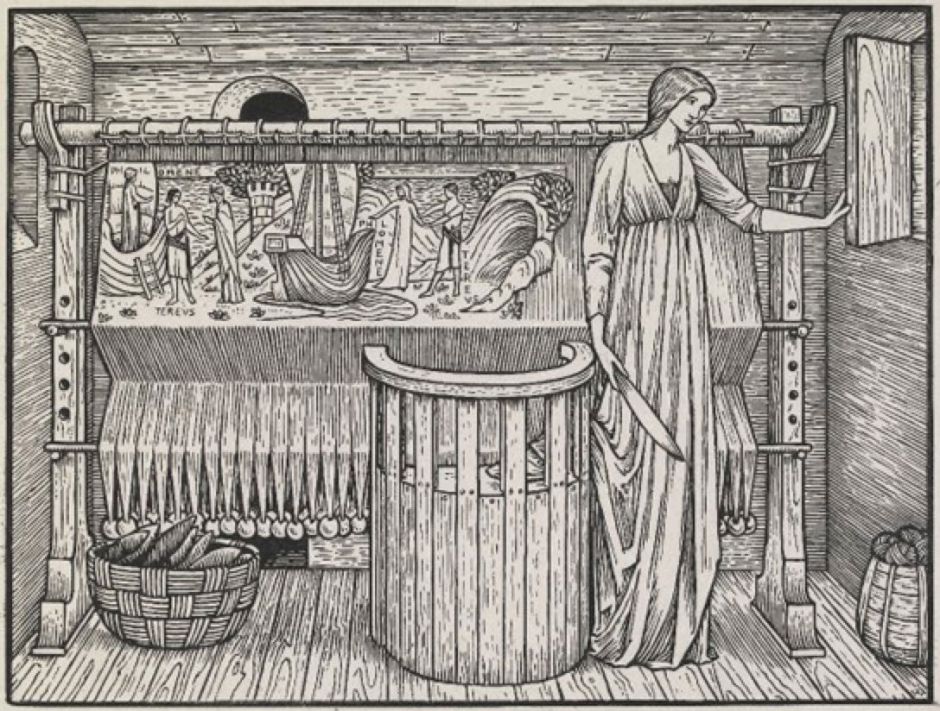
Almost at the turn of the century, Edward Burne-Jones told the harrowing story of Philomela (1896) in this ingenious wood engraving to illustrate The Legend of Goode Wimmen in the famous illustrated edition of the works of Chaucer published by the Kelmscott Press that year.
Philomela was raped by her brother-in-law the king of Thrace. When she refused to keep silent, he cut her tongue out and abandoned her in a remote hut. She is shown here weaving her story, carefully labelled, as her only means of communicating it, making this remarkable print a unique embedding of multiplex narrative within a single scene from that same story.
Just on the turn of the century, one of the first great painters of the twentieth century, Edvard Munch, used another variant of multiplex narrative in his work Saint Hans Night (The Dance of Life) (1899-1900).

This shows the artist dancing with his lover ‘Mrs Heiberg’ (Millie Thaulow), who is depicted as a mature and passionate woman in red. To the right is a man engaged more passionately with his partner; this is thought to represent the writer Gunnar Heiberg. One woman, who lacks a partner, is shown twice, at the left and right edges: she is Tulla Larsen, Munch’s later lover. At the left, she reaches out towards the flower of love, which will not let itself be taken. At the right, her hands are clasped in front of her in acceptance of her rejection.
This multiplex narrative therefore shows Munch’s two failed relationships in its single image: with Millie Thaulow, who rejected him, and with Tulla Larsen, whom he rejected.
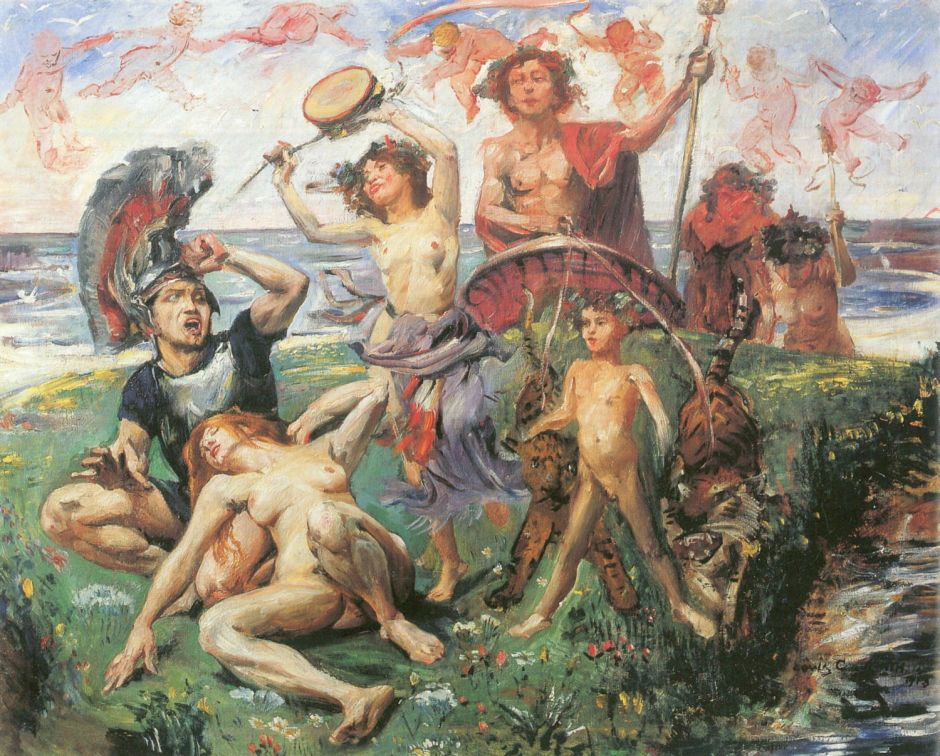
Just a year before the start of the First World War, Lovis Corinth’s Ariadne on Naxos (1913) combines passages from the whole of its story into a single image. Theseus (left) had promised Ariadne (naked on his thigh) that he would marry her after she helped him kill the Minotaur on Crete, but then sails away when she is still asleep, abandoning her on the island of Naxos. When he has gone, Bacchus arrives in his chariot (centre and right), falls in love with and marries her.
Until Munch’s painting of his troubled love life, multiplex narrative hadn’t been used in visual autobiography. That changed during the twentieth century, as my next example illustrates.
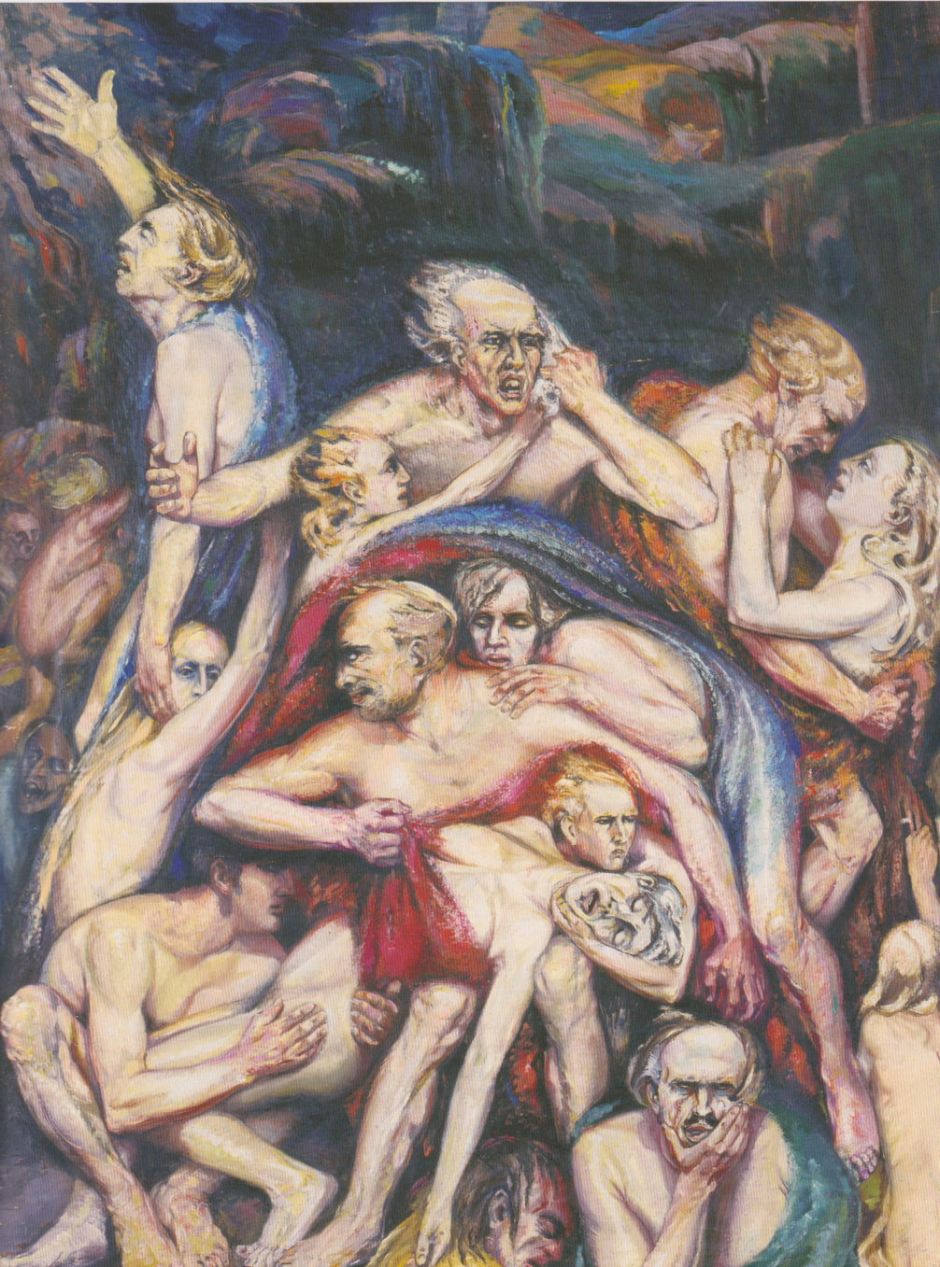
Without Peace (1921-22) is the late masterwork of Aksel Waldemar Johannessen in which he tells his life story in multiplex narrative. He appears at the centre, cradling the body of his dead wife on his thighs. Above are three separate self-portraits of him undergoing earlier crises, and other figures from his past crowd much of the rest of this large canvas.
Copyright prevents me from showing any more recent examples, apart from my last by the American artist Thomas Hart Benton.

At the centre of Benton’s Achelous and Hercules, Hercules, stripped to the waist and wearing denim jeans, is about to grasp Achelous’ horns. Immediately to the right, Deianira is shown in contemporary American form, with a young woman next to her bearing a laurel crown and seated on the Horn of Plenty.
To the left of centre, Benton shows a second figure of Hercules holding a rope, part of a passage referring to ranching and cowboys, and further to the left to the grain harvest. To the right, the Horn of Plenty links into the cultivation of maize (corn), the other major crop from the area.
These add another ten paintings and two prints to my collection of multiplex narrative, bringing the total number of paintings to 36, and spanning the period from classical Roman times to 1947.
Outside Europe and North America, multiplex narrative is also frequently encountered. I show here three of my favourite examples, from the Indian sub-continent and Japan.
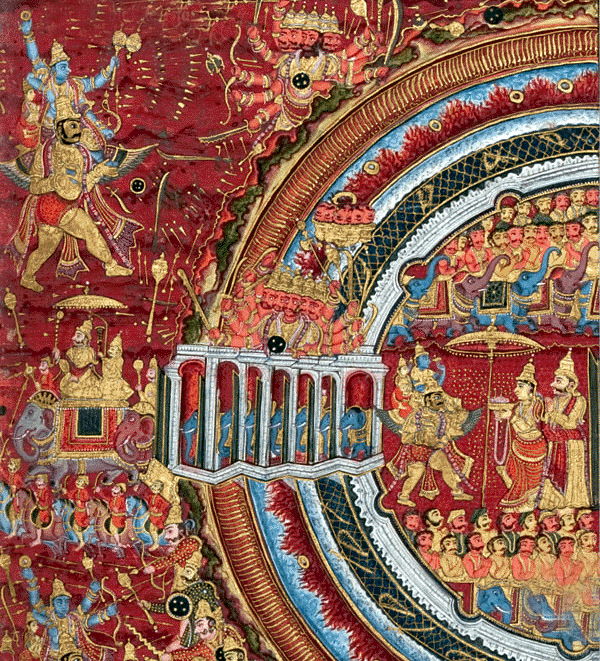
This detail of a miniature, Krishna Storms the Citadel of Narakasura from about 1840, contains two near-identical representations of Krishna, making it multiplex narrative.

East Asian narrative scroll paintings might seem to be inevitably multiplex in their form. Although that is true of many, such as the Heiji Monogatari Emaki (Sanjo Scroll) from the late 1200s, scrolls were typically viewed and read in short sections. The viewer may thus not read them as being multiplex, but as a series of individual frames of similar length, equivalent to a modern comic strip.
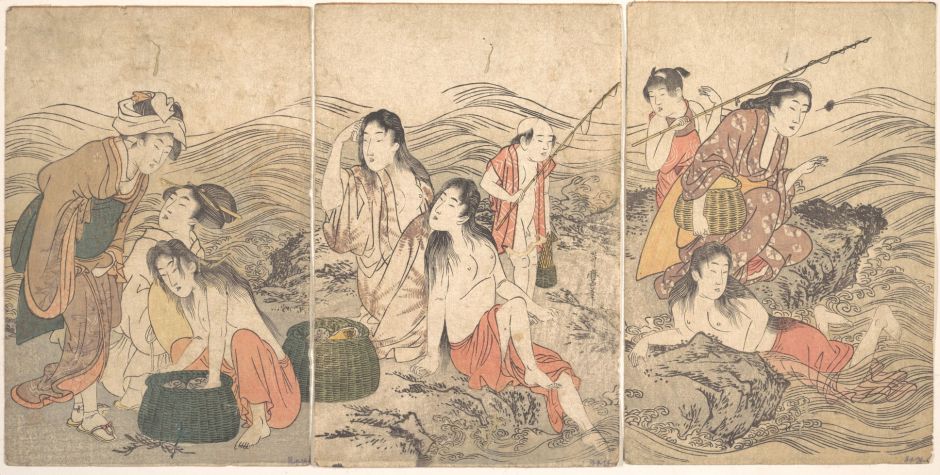
This more complex tradition also gives rise to some unusual intermediates. Kitagawa Utamaro’s (喜多川 歌麿) (c 1754-1806) Girl Fishers and Bathers, is triptych from 1791 which spreads a continuous motif across its three sheets. But the same topless woman appears in each sheet, making the whole a multiplex narrative.
I hope this dispels any stories about multiplex narrative becoming extinct after the Renaissance, or considering it an archaic mode of storytelling in visual art. It still fascinates viewers, particularly in its most recent incarnation in photography, thanks to Eadweard Muybridge and Étienne-Jules Marey.
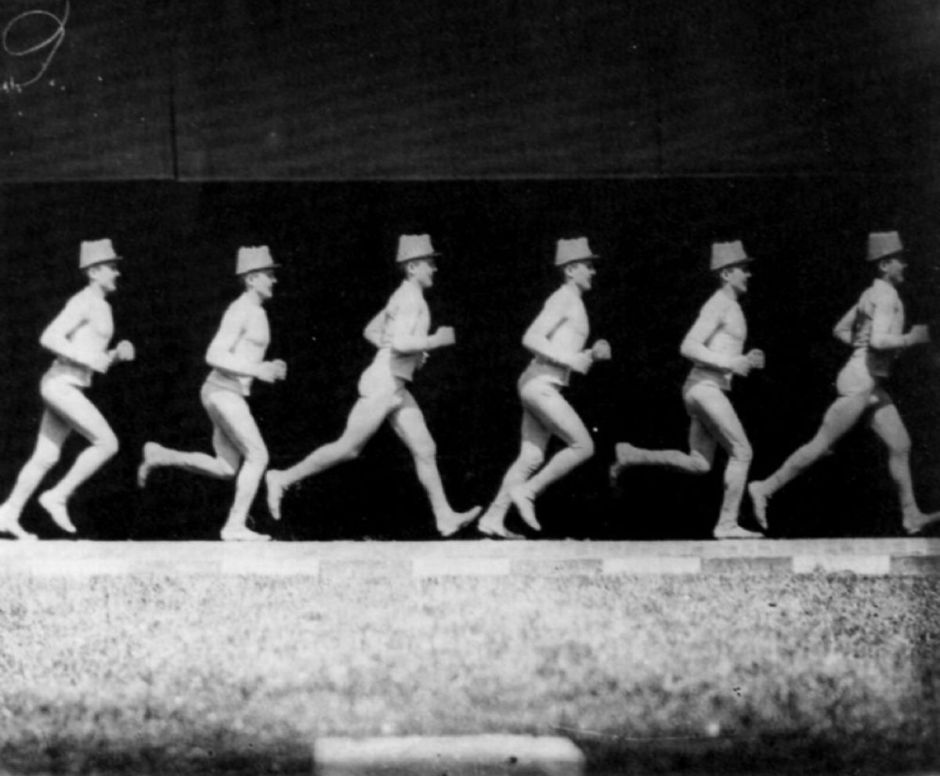
References
Lew Andrews (1995) Story and Space in Renaissance Art, the Rebirth of Continuous Narrative, Cambridge UP. ISBN 0 521 47356 X.
The Story in Paintings: Modes of painted narrative
Chinese Narrative Painting: Conclusions
Telling the story: narrative across media, including spoken, written, movies, graphic novels, paintings, photos, and music
The Story in Paintings: So what is a narrative painting?
Every picture tells a story: narrative paintings

